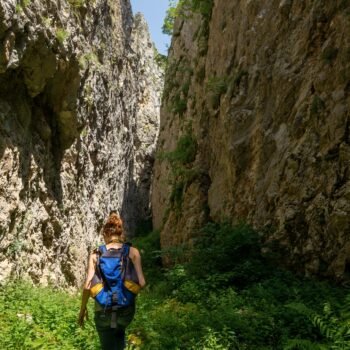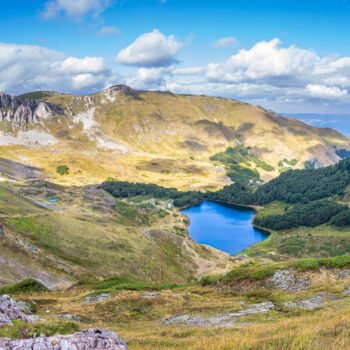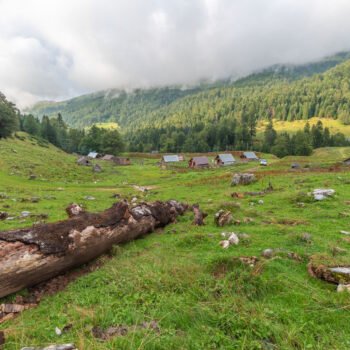- /
- Katun Road Untold Bjelasica
- /
- Legends
Legends
In the katuns, speaking, telling stories is the greatest enjoyment, imagination, savory food.
Living in harmony with nature (and in a constant struggle with it), wrestling with problems, phenomena nobody knew how to explain and account for, the people of this region created characters, legends, fairytales… The remains of pagan beliefs brought by the Slavs, mixed with the beliefs of the tribes that had already lived here. Bjelasica, steeping in dense, foggy forests, with strong winds howling over bare peaks, gorges and ravines, was the place where not only did fairies and dragons and winged horses find their place during long nights, but also various other mythological beings, monsters, demons, witches…
Enormous trees, still lakes, old watermills, piles of strange stones, lonely tombs, caves, strange object found in earth during plowing were all inspiration for the tales of wedding cemeteries, hidden (and found) treasure, emperors and kings, miners who never came out from mountain, fugitives, heroes and saints… These tales are a part of folklore, most likely historically unfounded, but still remembered by the people, as they were passed from generation to generation, just receiving new ornaments along the way.
Legend of the winged horse
When you look down from Zekova Glava, a peak where Vilina cave is situated, towards Pešića lake, it is somehow clearer how the legend of the winged horse, that lived in this lake, was created. At the bottom of a nature-made amphitheater, a calm, blue water sparkles, just as a piece of glass, surrounded in all the shades of playful green, and in shades of clouds dancing along the slopes. They flap, as if they really are wings.
Long, long time ago, during the nights when Bjelasica’s slopes bathed in the moonlight like in milk, two jets of water would fly up from the black, glistening surface of the lake, out of sudden, then two white wings would appear, and fairies, hidden behind trees, would tremble from excitement. Nothing was as beautiful as the winged horse flying in the moonlight. One of the fairies wanted the horse for herself. To caress him, to be the only one listening the rustle of the pearly feathers. She caught the blue eye of the white horse by dancing and singing, and then lured him into the cave. Her happiness was immeasurable, but it didn’t last for long. Envy made her friends catch the horse and smear his wings with resin. Seeing him stagger around, helpless and sad, they repented, but it was too late. And the fairy, who wanted the horse for herself, died in grief.
An ordeal of wedding guests
Montenegrin wedding guests from Morača were riding their horses along the Šiško Lake, when they suddenly met Turkish wedding guests from Berane. Turks shouted to Montenegrins to get out of their way, but then a Montenegrin flag bearer stepped in and threatened:
Move, so that we, people from Morača, can pass, we have never paid you taxes! – then he pulled out his Yatagan sword and rushed towards villains. Other people in the group rushed after him, the battle started, a real slaughter, and all the wedding guests died, the Turkish one and Montenegrin, as well. The only survivors of the battle were the two brides and they returned to their home. They were all buried in the same grave, a heavy stone was pulled over it. It still stands beside the Šiško lake.
Wedding cemetery
There are three of these, so called, wedding cemeteries on Bjelasica: the one on Ključ, in Rijeka Mušovića and the third one on Šiška.
These are, in fact, piles of scattered and erect stones, tombstones and necropolis. These traces of people who lived here long time ago, are the foundation for romantic tales and legends of tragic encounters along the narrow mountain paths.
The place called Svatovsko groblje (Wedding cemetery) is a bit unusual. This pass, situated almost at the top of the mountain, is a place where the grass never grows and where winds always blow. They cross paths, because roads and paths, friends and enemies, folk tales have always crossed paths here.
According to one of the tales, many years ago, a groom’s family from Mojkovac went across Bjelasica to take the bride. On their way back, they were hit by a severe storm. Blizzard swept them away at the pass, the wedding party froze and they were all buried there.
There are several assumptions about the time when these cemeteries were made. Some believe these were two-religious cemeteries from the period when Christians began converting into Islam in certain parts (legend of the cemetery next to the Šiško lake). Others, on the other hand, believe they are older, certainly from the Slavs period, but before they converted to Christianity, and that old rituals were performed there.
According to the legend, encounters of wedding processions on horses took place a long time ago and ancient customs dictated that it was a taboo to turn from the path. It was this turning from the path, or giving way to the other procession, that caused a large misfortune and bad fate for those who hadn’t even begun their happy life together. Then, an argument would start and soon after the first heads would fall.
Another legend says that a famous and rich trader from Kolašin, Akan Marić, found a buried treasure right at the wedding cemetery on Bjelasica. He was given a map by his wife, who was the last descendent of an old pre-Slav, Illyrian family.
How was Biogradsko lake formed
Two brothers were skinning the barley at the threshing floor on Bjelasica and the older brother began dividing the grain in two, because the younger one was blind. He filled up the deeper side of the measuring cup, brought it to his brother and asked:
- Is it full, brother?
The younger one ran his hand over the surface and said:
- Yes, it is, brother.
The older poured the grain into his sack. Then he filled the shallow side of the measuring cup and, again, brought it to his sibling. The younger touched the surface and confirmed it was full. The older poured the smaller cup of grains into his brother’s sack. The same process continued until all the grains were shared. The older brother than asked:
- Are you all right with how we divided the grains, brother?
The blindman answered:
- If you shared fairly, I am all right.
The older one swore then:
- If I haven’t shared it right, let the ground opens under me.
But, at the very moment he said those words, the sun set, the sky darkened, a storm with lightning and thunder started, the earth started shaking, it opened and swallowed the perjurer.
Then, a great rain started and it didn’t cease for three days and three nights. On the fourth day, it stopped and a lake appeared on the field. A rock stood in the middle of the lake, with a petrified older brother on it.
People named the lake Biogradsko and the islet that appears even today, when the water level is lower is called Gumno.
Fairies circle
A healing spring, called Fairies Spring or Fairies Water by the folk, is situated on the mountain of Ključ. Close to the spring, a circle is set, a small plateau where the grass is always green, even when everything around dries out and turns yellow. Not so long ago – a story goes -a man was riding his horse there, and when they got close to the water, his horse stumbled and they both fell, they barely got up. Fifteen days after the man had got back home, his horse died and one side of his body completely withered, from head to toe. He had been ailing for five years, spending half of his property on paying priests and monks, then on sorcerers and sorceresses, who finally told him that they had read in books that fairies shot him. And so, his family carried him to the Fairies water and left him there and he – as the folks say – started begging the fairies out loud: “I implore you fairies, my stepsisters, I beg you upon sky and earth, upon mountain and water and all the springs in the mountain, please heal me!” Fairies heard him begging and calling them stepsisters, they took pity on him and healed him with some mountain herbs.
Saxons – the best miners, the fastest blacksmiths
At the foot of Bjelasica, Serbian emperor Dušan found some gold and silver and he brought Saxons, the people of another religion, from afar, to melt the ore and mint royal coins. Skillful craftsmen set to work and minted a pile of gold coins soon. The emperor was astonished when he saw so many coins, he grabbed them and exclaimed:
- Nobody minted so fast (brzo kovo) – and the mine got its name Brskovo after his words.
Deliriously happy, the emperor couldn’t stop wondering:
- My minted coins – he repeated – my minted coins (moj kovan novac) – and so the new settlement located close to the mine, was given the name Mojkovac.
Bishop’s cave
A legend from the eastern slopes talks about a simultaneous stay of Slavs and Romans in the Tara and Lim basins. A confirmation of its historical background can be found in the documents of the priest Dukljanin, where he noted the details of a conflict between two bishops, Ljutomir from Raška and Pavlimir, a Roman one. According to Dukljanin, Pavlimir killed Ljutomir and according to the folk’s tales from this Polimlje region, the opposite happened. Roman bishop, who ruled in Samograd, a town 3 kilometers away from Lubnice, in the Bistrica canyon, hid in a cave, which was later called the Bishop’s cave.
According to the legend, while chasing the bishop, Ljutomir encamped on a plateau opposite the cave. Then he gave the order to his soldiers to cut the trees around the entrance to the cave, and light a large fire there, and when they did it, the strong and thick smoke found its way into the cave and started suffocating the people inside. Bishop’s wife, who was also Ljutomir’s sister, asked her brother to let her go out of the cave with her servants and chests. She was allowed to leave. She, then, locked her husband, Pavlimir, in a large chest and carried him out of the cave, and took off toward Praćevac, with her servants. Ljutomir entered the cave and killed all the people from the bishop’s escort but he couldn’t find the man himself. At that moment, he recalled his sister, the servants and the chest and set out in search of them. He caught up with them, took the bishop out of the chest and killed him.
Stony River
There is a river on Bjelasica whose burble no one has ever heard, river where no one tried to look at his/her reflection, nor washed his/her face with it. The stony river.
All the sides of Troglava mountain are overgrown in grass and blueberries. That is why people find it so surprising when they see a pile of stones, approximately same in size and in sharp lines which “flows” down a steep section on the northern side of Troglava. As if, once upon a time, a true river rushed down the mountain and then it dried up suddenly when it reached the valley. And, by some miracle – it petrified.
Vragodo (Devil’s valley) and Jelina katunina
This is a legend of devil’s valley, a place where devils dance and never sleep. Or perhaps, it is a legend of Saxon miners. Or, above everything else, a legend of Saxon blacksmiths, clad in animal skin, who minted silver coins and legends.
A narrow valley leading from the Šiško lake towards Jelina katunina, abounds in unusual shapes, that are even creepy sometimes. Frequent fog covering the area is certainly a reason for the idea that landscape architects here were devilish forces and masters. Weak grass, rocks protruding from the ground, gnarled or lightning-burned and broken trees are certainly not a pleasant scenery for a twilight walk. The old huts in Jelina katunina, where sun hardly breaks through the tree canopy, like in a fairytale, dive into the land, hide under the moss or have completely disappeared.
The path through the dense beech forest leads to a grassland, whose name has become well-known in recent years due to the announcements it would be a place of a new ski resort. However, there’s nothing frightening or ominous at the katun. The first, “unpleasant” landscape is not the reason for its name, but the strange occurrences that can be seen there. Glass fragments of molten rock protruded from the ground. Shepherds used to find some strange objects here.
For years, strange sounds and fire could be heard and seen from the grassland where the katun Vragodo was situated. It is assumed that the tireless Saxon miners used to live here. They would melt the ore in large furnaces and mint the coins, together with a legend of devil’s valley, where devils danced and never slept…
Power (blade) of the volcano
A place situated on the slopes surrounding Bjelasica is called Belegija.
Once upon a time, when the meadows were mowed with a scythe and the hay was pulled away by the oxen and horses, stone slabs were dug from there and used for making belegija – a grinder for sharpening scythes. Every hut had its own Belegija grinder. Every mower knew that the best grinders came from Belegija. Grinders were brought even from Italy, produced in their factories, but they couldn’t tarnish the fame nor surpass the quality of the one here created by the nature for millions of years. Belegija was carried in a hollowed-out piece of wood, half filled with water, the mower would pull it out when he finished mowing and sharpen it. The scythe would “sing” after that. Today, though rarely, one can still hear the sharp sound of the grinder from Belegija, made of hard volcanic stone.







